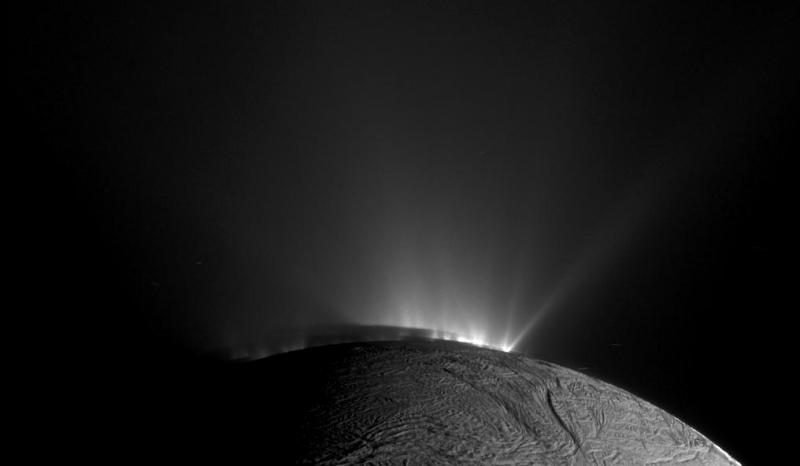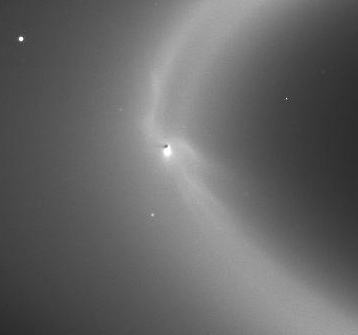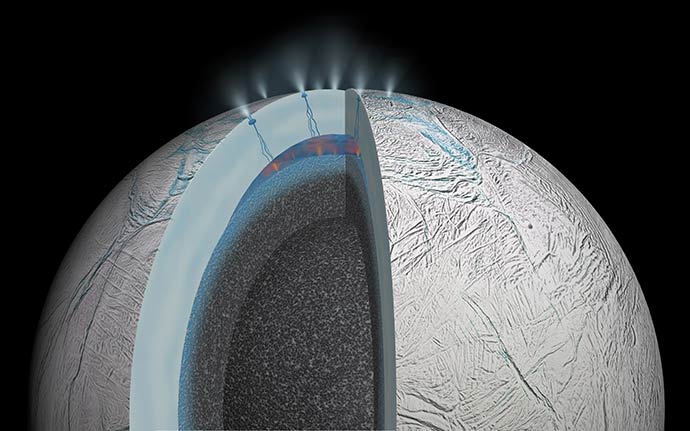2015 March 12
New evidence for deep subsurface oceans on Enceladus
 |
| When Enceladus is lit from behind, scattered sunlight make the vast extent of its geysers especially apparent. Image courtesy of NASA/Cassini. |
New evidence has emerged that supports the existence of large oceans of liquid water beneath the surface of Saturn’s moon Enceladus.
Writing in today’s edition of the Journal Nature, researchers analyse the sizes and composition of dust particles in the planet’s diffuse outer E-ring, as measured by the Cassini spacecraft.
The particles that make up Saturn’s E-ring principally come from geysers on Enceladus, which spew vast quantities of icy material into space. As a result, the material in the ring is a probe of what lies unseen beneath the moon’s surface.
Like all of Saturn’s rings, the bulk of the material which makes up the E-ring is ice – no surprise since Enceladus’s surface is covered with thick ice deposits. But Cassini has also detected traces of tiny silicon dioxide particles – the same mineral that sand is made from on Earth.
 |
| Enceladus seen by Cassini in silhouette amid the E-ring. Image courtesy of NASA/Cassini. |
What is unusual about these grains of rock is that they are all of a very similar, and very small, size. The majority range only between 2 nm and 8 nm, containing only a few thousand atoms.
On Earth, only one process is known which can make such small sand grains. This is when silicate rocks dissolve in very hot alkaline water, and then return to the solid state as the water cools. Over time, the solid grains grow larger as more of the dissolved rock solidifies onto their surfaces.
Two characteristics of the sand grains in Saturn’s E-ring are particularly startling. Firstly, they are so numerous compared to the ice grains (around 150 ppm) that they must have formed from a very concentrated solution of dissolved silicate. Such concentrations could only be achieved at temperatures of 90°C or higher, at a depth of at least 40 kilometres beneath the surface of Enceladus.
Secondly, the small size of the grains suggests that they must have cooled quickly, before they had time to grow any larger. It suggests that the material spewing out of Enceladus’s geysers has risen from deep beneath its surface within the space of only a few years.
 |
| An artist’s impression of Enceladus’s interior structure, as proposed by Hsu et al.. Image courtesy of NASA. |
Put together, these observations seem to suggest that within Enceladus there are colossal reservoirs of hot water in close contact with rock, which is able to flow quickly up to the surface. That means it must be in a liquid state.
Warm mineral-rich water is an ideal environment for life, opening the question of whether Enceladus might have marine life buried deep beneath its surface. But given it could only exist tens of kilometres beneath the surface, and we do not have the technology to drill to such depths even on Earth, these seas are likely to remain unexplored for some decades to come.
References
| The British Astronomical Association supports amateur astronomers around the UK and the rest of the world. Find out more about the BAA or join us. |
